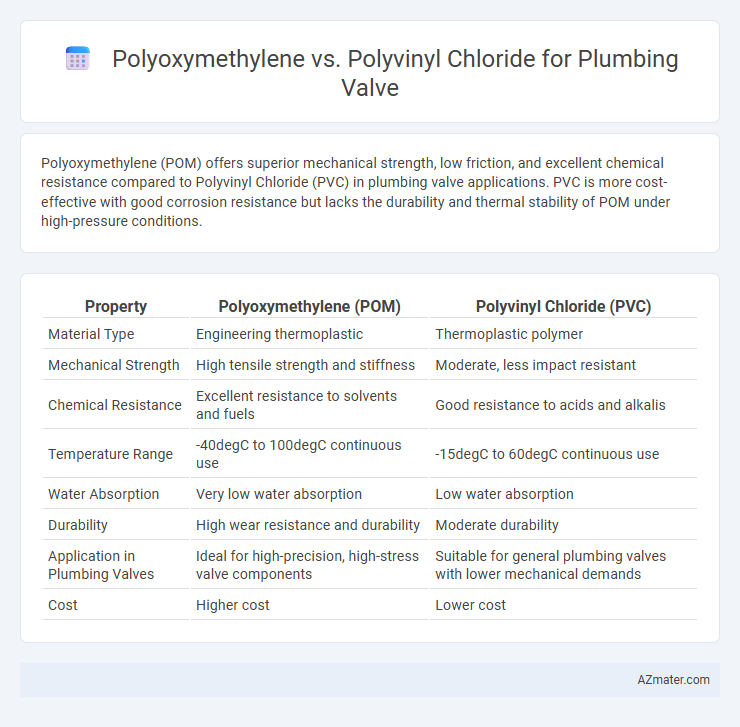Polyoxymethylene (POM) offers superior mechanical strength, low friction, and excellent chemical resistance compared to Polyvinyl Chloride (PVC) in plumbing valve applications. PVC is more cost-effective with good corrosion resistance but lacks the durability and thermal stability of POM under high-pressure conditions.
Table of Comparison
| Property | Polyoxymethylene (POM) | Polyvinyl Chloride (PVC) |
|---|---|---|
| Material Type | Engineering thermoplastic | Thermoplastic polymer |
| Mechanical Strength | High tensile strength and stiffness | Moderate, less impact resistant |
| Chemical Resistance | Excellent resistance to solvents and fuels | Good resistance to acids and alkalis |
| Temperature Range | -40degC to 100degC continuous use | -15degC to 60degC continuous use |
| Water Absorption | Very low water absorption | Low water absorption |
| Durability | High wear resistance and durability | Moderate durability |
| Application in Plumbing Valves | Ideal for high-precision, high-stress valve components | Suitable for general plumbing valves with lower mechanical demands |
| Cost | Higher cost | Lower cost |
Introduction to Polyoxymethylene (POM) and Polyvinyl Chloride (PVC)
Polyoxymethylene (POM) is a high-performance engineering thermoplastic known for its excellent mechanical properties, including high stiffness, low friction, and superior dimensional stability, making it ideal for precision plumbing valves. Polyvinyl Chloride (PVC) is a widely used plastic polymer valued for its chemical resistance, durability, and cost-effectiveness in plumbing applications, particularly in water supply and drainage systems. Both materials offer unique advantages: POM excels in wear resistance and load-bearing capacity, while PVC provides robust corrosion resistance and ease of installation.
Chemical Composition and Structure Comparison
Polyoxymethylene (POM) is a thermoplastic polymer characterized by repeating oxymethylene (-CH2O-) units, providing high crystallinity and strong intermolecular bonding, which results in excellent mechanical strength and chemical resistance in plumbing valves. Polyvinyl Chloride (PVC) consists of vinyl chloride monomers with chlorine atoms attached to the polymer backbone, offering good corrosion resistance but lower mechanical strength compared to POM. The structural differences between POM's simple, linear chain and PVC's bulky chlorine-substituted chain influence their respective durability, flexibility, and resistance to chemical degradation in plumbing applications.
Mechanical Strength and Durability Assessment
Polyoxymethylene (POM) exhibits superior mechanical strength and dimensional stability compared to Polyvinyl Chloride (PVC), making it more resistant to impact and wear in plumbing valves. Durability assessments reveal that POM maintains its integrity under high pressure and temperature fluctuations better than PVC, which is prone to brittleness and deformation over time. These properties make POM a preferred material for high-performance, long-lasting plumbing valve components.
Corrosion and Chemical Resistance in Plumbing Applications
Polyoxymethylene (POM) offers superior chemical resistance and low susceptibility to corrosion compared to Polyvinyl Chloride (PVC), making it ideal for plumbing valves exposed to various aggressive chemicals and fluctuating pH levels. PVC tends to degrade under prolonged exposure to strong solvents and extreme temperatures, leading to potential valve failures and maintenance issues. The enhanced durability of POM in corrosive environments extends valve lifespan and ensures reliable performance in demanding plumbing systems.
Temperature and Pressure Tolerance Differences
Polyoxymethylene (POM) exhibits superior temperature resistance compared to Polyvinyl Chloride (PVC), maintaining structural integrity up to 100degC, while PVC typically withstands temperatures up to 60degC, limiting its use in high-heat plumbing applications. In terms of pressure tolerance, POM valves can endure pressures exceeding 10 MPa due to their high mechanical strength and low creep characteristics, whereas PVC valves generally cope with pressures around 6 MPa but may deform under sustained high loads. These differences make POM more suitable for demanding plumbing valve applications requiring elevated temperature and pressure performance.
Installation Process and Handling Requirements
Polyoxymethylene (POM) valves offer superior dimensional stability and are easier to machine, enabling a streamlined installation process that reduces fitting adjustments compared to Polyvinyl Chloride (PVC) valves. PVC valves require careful cleaning and solvent cement application to ensure leak-proof joints, whereas POM valves typically rely on precise machining and mechanical fittings to achieve secure connections. Handling POM demands precautions against excessive heat and chemical exposure to maintain material integrity, while PVC's brittleness under low temperatures necessitates careful handling to prevent cracking during installation.
Longevity and Maintenance Considerations
Polyoxymethylene (POM) offers superior chemical resistance and mechanical strength compared to Polyvinyl Chloride (PVC), enhancing longevity in plumbing valve applications by reducing wear and corrosion over time. PVC valves, while cost-effective, are more susceptible to degradation under UV exposure and chemical stress, which may increase maintenance frequency and the risk of leaks. Selecting POM valves minimizes long-term maintenance costs and extends service life, making them ideal for high-demand plumbing systems requiring durability and reliability.
Cost Analysis: POM vs. PVC for Plumbing Valves
Polyoxymethylene (POM) plumbing valves typically exhibit higher upfront costs compared to Polyvinyl Chloride (PVC) valves due to their superior mechanical strength and chemical resistance, making them ideal for demanding applications. PVC valves are more cost-effective for standard plumbing systems, benefiting from lower material costs and ease of fabrication, which reduces overall installation expenses. When evaluating total lifecycle cost, POM valves may offer savings through enhanced durability and reduced maintenance frequency despite the initial investment premium.
Environmental Impact and Recyclability
Polyoxymethylene (POM) offers superior durability and chemical resistance compared to Polyvinyl Chloride (PVC), contributing to extended valve lifespan and reduced environmental waste. PVC valves, while widely used, pose greater environmental concerns due to chlorine content releasing harmful dioxins during incineration and limited recycling infrastructure. POM's thermoplastic nature facilitates easier recycling processes, enhancing its sustainability profile in plumbing valve applications.
Final Recommendation: Choosing the Right Material for Plumbing Valves
Polyoxymethylene (POM) offers superior chemical resistance and dimensional stability, making it ideal for plumbing valves exposed to various fluids and temperatures. Polyvinyl Chloride (PVC) is cost-effective with good corrosion resistance but can be less durable under high mechanical stress and temperature fluctuations. For long-term performance and reliability in plumbing valves, POM is generally the preferred material, especially in demanding environments requiring enhanced strength and wear resistance.

Infographic: Polyoxymethylene vs Polyvinyl Chloride for Plumbing Valve
 azmater.com
azmater.com